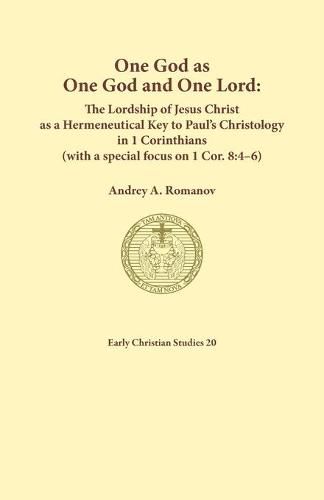Readings Newsletter
Become a Readings Member to make your shopping experience even easier.
Sign in or sign up for free!
You’re not far away from qualifying for FREE standard shipping within Australia
You’ve qualified for FREE standard shipping within Australia
The cart is loading…






This title is printed to order. This book may have been self-published. If so, we cannot guarantee the quality of the content. In the main most books will have gone through the editing process however some may not. We therefore suggest that you be aware of this before ordering this book. If in doubt check either the author or publisher’s details as we are unable to accept any returns unless they are faulty. Please contact us if you have any questions.
This exegetical analysis of 8:4-6 contributes to the ongoing discussion on Paul’s Christology and its role in the development
of Early Christian thought. Paul’s representation of Jesus Christ as the Lord is analyzed in relation to Hellenistic, Roman, and Jewish
religious worldviews in which other figures were also called lords. Implying a correlation between status and function of a particular
lord and therefore denoting objective characteristics, ‘Lordship’ allows the categorization of various
-figures and the discernment
of Christ’s peculiarities as
.
For Paul, ‘one God the Father’ and ‘one Lord Jesus Christ’ are coworkers in the universal process from creation to salvation. These unique functions indicate their unique status as the absolute Lords. Jewish tradition already presented the God of Israel as One true God because He is the absolute Lord, but now Paul includes both God the Father and the Lord Jesus Christ in the One Godhead.
This analysis points to the historical and theological continuity in understanding and transmission of Christian Truth. The Christology
of the Church Fathers is deeply rooted in Paul’s representation of the figure of Christ.
$9.00 standard shipping within Australia
FREE standard shipping within Australia for orders over $100.00
Express & International shipping calculated at checkout
This title is printed to order. This book may have been self-published. If so, we cannot guarantee the quality of the content. In the main most books will have gone through the editing process however some may not. We therefore suggest that you be aware of this before ordering this book. If in doubt check either the author or publisher’s details as we are unable to accept any returns unless they are faulty. Please contact us if you have any questions.
This exegetical analysis of 8:4-6 contributes to the ongoing discussion on Paul’s Christology and its role in the development
of Early Christian thought. Paul’s representation of Jesus Christ as the Lord is analyzed in relation to Hellenistic, Roman, and Jewish
religious worldviews in which other figures were also called lords. Implying a correlation between status and function of a particular
lord and therefore denoting objective characteristics, ‘Lordship’ allows the categorization of various
-figures and the discernment
of Christ’s peculiarities as
.
For Paul, ‘one God the Father’ and ‘one Lord Jesus Christ’ are coworkers in the universal process from creation to salvation. These unique functions indicate their unique status as the absolute Lords. Jewish tradition already presented the God of Israel as One true God because He is the absolute Lord, but now Paul includes both God the Father and the Lord Jesus Christ in the One Godhead.
This analysis points to the historical and theological continuity in understanding and transmission of Christian Truth. The Christology
of the Church Fathers is deeply rooted in Paul’s representation of the figure of Christ.